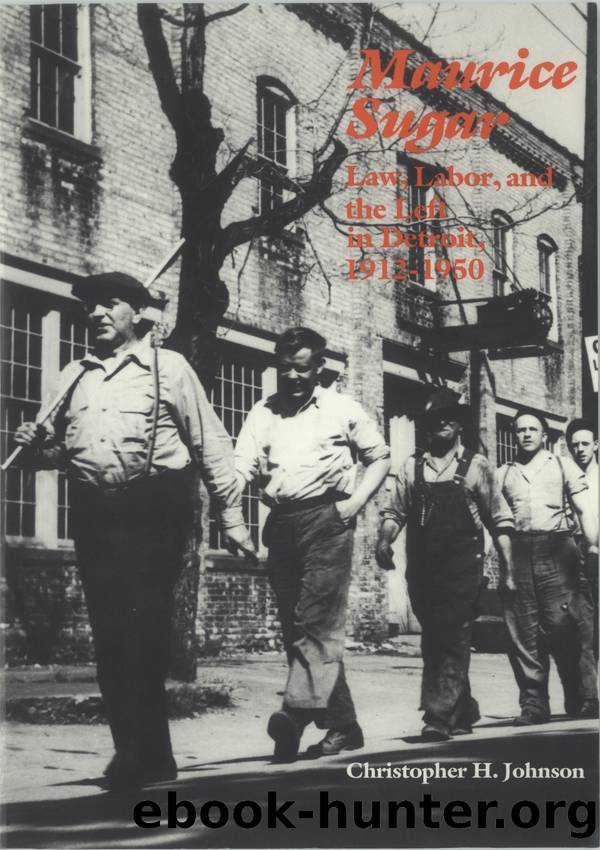Maurice Sugar by Johnson Christopher H.;

Author:Johnson, Christopher H.;
Language: eng
Format: epub
Publisher: Wayne State University Press
Published: 2017-08-30T00:00:00+00:00
7SIT DOWN, YOUâVE GOTâEM BEAT
Throughout 1936, industrial unionism was on the march. The CIO parted ways with the AFL and, under John L. Lewisâs resolute direction, opened a new era in the history of the U.S. labor movement. In January the Akron rubber workers struck against the big three manufacturers. Using the âstay-inâ tactic that rank-and-filers at Firestone initiated, they won important gains. The sit-down strike, as it soon would be called, had an honorable history. Under the name of âfactory occupation,â this tactic was widely used in the great North Italian movement in 1919â20 and had been employed by the Wobblies in the United States. More recently, it was the chief tactic employed in the great strike wave in France during the summer of 1936. It was a close relative of the British-designed âwork-to-ruleâ strategy, a slowdown strike in which every work regulation was followed to the letter, destroying normal operations without actually walking off the job.
The advantages of the sit-down were immediately recognized. As later enumerated by UAW leaders for the Christian Science Monitor, they included:
1. Effectivenessâwhen workers stay in a factory they hinder the company from attempting to operate with new men, minimize strike-breaking, and shut off production most efficiently.
2. Peacefulnessâviolence is reduced by strikers being inside, instead of massed in picket lines without, and liable to clash with police.
3. Best for union moraleâstrikers sticking together in a factory can keep up their enthusiasm better than going their separate ways outside, subject to disintegrating influence and rumor.
In late 1936 automobile workers used the sit-down in several stoppages in the Detroit area, notably at Midland Steel Products and Kelsey-Hayes Wheel.1
The essential goal of sit-downs and other job actions during this period was union recognition. The UAW, well supplied with cash and good advice from the CIO hierarchy, had generated a tremendous organizing drive during the summer and fall. The most effective way to demonstrate a unionâs power (especially in a context where slower means could be dissipated by company espionage and intimidation) was the strike. Organizers like Stanley Nowak, Roy Reuther, or Robert Travis understood this well, but late 1936 presented a special problem. Auto production was booming and many workers were shedding their old fears. The chief difficulty was knowing when the appropriate moment to act had arrived. Even the most militant leaders found themselves being outstripped by the ranks. Nowak, for instance, thought the Automotive-Fibers strike was premature.
As it turned out, in contrast to some of the disastrous strikes of yesteryear, spontaneity generally bore positive fruit. A class-conscious sense of destiny seemed to grip the workers of southeastern Michigan. The frustrations bottled up for years exploded into unified action without historical parallel. The recriminations and political backbiting that plagued strikes in the past all but disappeared. For five months the region became the focal point of the world labor movement.
Like all such great moments in the past, the surge came from below. But it would not be accurate to argue, as does Jeremy Brecher, that the success of the great CIO organizational drive came despite leadership.
Download
This site does not store any files on its server. We only index and link to content provided by other sites. Please contact the content providers to delete copyright contents if any and email us, we'll remove relevant links or contents immediately.
Hit Refresh by Satya Nadella(8345)
When Breath Becomes Air by Paul Kalanithi(7273)
The Girl Without a Voice by Casey Watson(7271)
Do No Harm Stories of Life, Death and Brain Surgery by Henry Marsh(6342)
A Court of Wings and Ruin by Sarah J. Maas(6114)
Hunger by Roxane Gay(4234)
Shoe Dog by Phil Knight(4181)
Everything Happens for a Reason by Kate Bowler(4075)
A Higher Loyalty: Truth, Lies, and Leadership by James Comey(4039)
The Rules Do Not Apply by Ariel Levy(3913)
Tuesdays with Morrie by Mitch Albom(3840)
The Immortal Life of Henrietta Lacks by Rebecca Skloot(3833)
How to Change Your Mind by Michael Pollan(3686)
Millionaire: The Philanderer, Gambler, and Duelist Who Invented Modern Finance by Janet Gleeson(3576)
All Creatures Great and Small by James Herriot(3527)
Elon Musk by Ashlee Vance(3461)
Tokyo Vice: An American Reporter on the Police Beat in Japan by Jake Adelstein(3441)
Man and His Symbols by Carl Gustav Jung(3326)
The Money Culture by Michael Lewis(3291)
